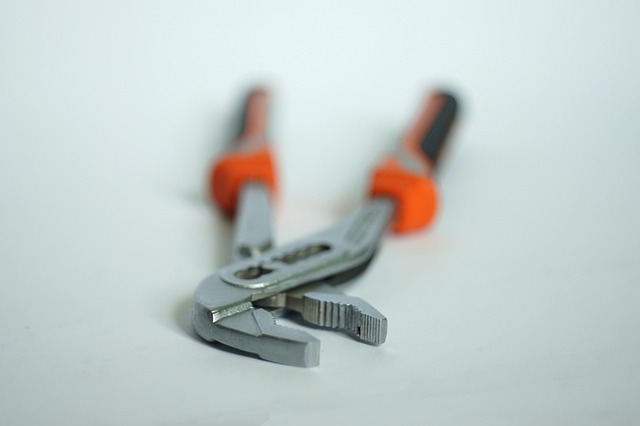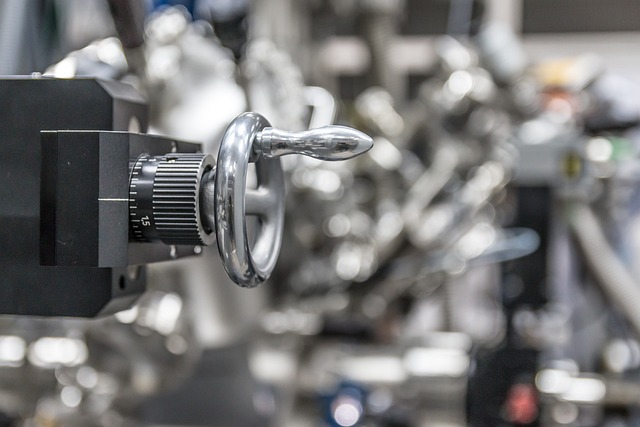Homeowners can effectively manage plumbing emergencies like clogged drains and leaky faucets using tools like drain snakes, boiling water solutions, or DIY repairs for worn washers. Regular maintenance, quick troubleshooting, and knowing when to call an emergency plumber prevent severe crises. Essential tools include pliers, wrenches, leak detection solutions, and multi-tools. For leaking pipes, turn off the main valve and use temporary sealing agents until a professional arrives. DIY methods like plungers or baking soda/vinegar address minor clogs, but recurring issues may require professional help. A running toilet due to leaky flapper or faulty fill valve can be quickly fixed by homeowners with basic tools. Water heater emergencies demand swift action; assess issues and conduct regular maintenance checks for problems. Assess emergencies with main water shut-off valve checks, plungers, or chemical cleaners before calling an emergency plumber. Regular plumbing inspections prevent breakdowns and costly calls. Severe flooding, unusual pipe noises, low water pressure, and temperature inconsistencies signal professional intervention.
In every home, knowing how to handle plumbing emergencies can save time and money. From leaking pipes to a running toilet, understanding common issues and having the right tools is crucial. This guide covers quick fixes for various emergencies, empowering homeowners with essential skills. Learn about necessary tools, temporary solutions, unclogging methods, and water heater crises. Additionally, discover preventative measures and recognize severe issues that demand professional attention, ensuring you’re prepared when an emergency plumber is needed.
Understanding Common Emergency Plumbing Issues

Plumbing emergencies can happen at any time, and knowing common issues can help you tackle them effectively. Clogged drains top the list, often caused by foreign objects or grease buildup. A simple drain snake or boiling water solution might be all you need to clear the blockage. Another frequent emergency is a leaky faucet—a telltale sign of worn-out washer or cartridge. Replacing these components is usually a straightforward DIY task for homeowners.
If you’re dealing with low water pressure, it could be due to mineral buildup in the pipes, a faulty pressure regulator, or even a broken main supply line. Identifying the source requires some detective work, but many basic repairs can be performed by calling in an emergency plumber. Regular maintenance and prompt action when issues arise are key to avoiding severe plumbing crises.
Tools Every Homeowner Should Have for Quick Fixes

When it comes to handling plumbing emergencies, being prepared is key. As an emergency plumber, we often emphasize that a well-equipped toolkit can save time and potentially prevent further damage. Every homeowner should consider stocking essential tools that allow them to tackle basic plumbing issues swiftly. A reliable set of pliers for gripping and twisting pipes, a versatile wrench capable of handling various fittings, and a pair of needle-nose pliers are indispensable. These simple yet effective tools empower you to turn off valves, tighten connections, or remove stubborn objects from drains.
Additionally, having a good quality multi-tool that combines several functions, including a cutter and screwdrivers, can be incredibly handy. A leak detection solution is another valuable addition; these products help identify problems before they become major disasters. With the right tools at hand, homeowners can confidently handle minor plumbing emergencies until a professional emergency plumber arrives.
Temporary Solutions for Leaking Pipes

In the event of a leaking pipe, especially during an emergency when an immediate fix is crucial, there are temporary solutions you can implement to prevent further damage before contacting an emergency plumber. One quick remedy is to turn off the main water supply valve, often located near the meter or in easily accessible areas like basements or closets. This simple step stops the flow of water and prevents leakage.
For immediate relief, consider using waterproof materials like towels or plastic sheeting around the leak to absorb excess moisture. You can also try applying temporary sealing agents or tape designed for such emergencies, offering a stopgap measure until a professional plumber can assess and fix the issue permanently. Remember, these are short-term fixes, and an emergency plumber’s expertise is essential to address the root cause of the leak effectively.
Unclogging Drains Without a Plumber

In the event of a clogged drain, many people turn to an emergency plumber for immediate relief. However, there are DIY methods that can unclog drains without professional intervention. The key is to act quickly and use the right tools. Start by using a plunger, applying pressure down the drain to create a suction effect. This simple yet effective method works wonders for minor clogs caused by hair, grease, or food particles.
For stubborn clogs, mix baking soda and vinegar; pour this mixture down the drain followed by hot water. The chemical reaction between baking soda and vinegar helps break down blockages. Alternatively, use a metal hang glove to remove any visible obstructions. Remember, these quick fixes are temporary solutions for emergency situations, but recurring issues may require professional plumbing services.
Fixing a Running Toilet

A running toilet is a common plumbing emergency that can waste a significant amount of water and increase your utility bills. Often, this issue stems from a leaky flapper or a faulty fill valve. As an emergency plumber, addressing this promptly is crucial to prevent excessive water damage and wasted resources. A simple fix involves turning off the water supply to the toilet, accessing the internal components, and replacing the worn-out parts with new ones.
You can save time and money by learning this quick plumbing fix. It’s a common problem that an emergency plumber often encounters, so having the know-how to tackle it yourself can be invaluable. With just a few basic tools and a replacement flapper or fill valve, you can stop the water flow and restore your toilet to its efficient self, without needing to wait for a professional to arrive.
Handling Water Heater Emergencies

In any home, water heater emergencies can occur at the most inconvenient times. As an emergency plumber, it’s crucial to know how to handle these situations swiftly. If your water heater is making unusual noises, showing signs of corrosion, or if hot water production has abruptly ceased, it may be a sign of a problem. The first step is to turn off the gas supply (if applicable) and electric power to the unit for safety. Then, assess the situation: is it a simple issue like a leaking dip tube or a more complex problem with the heating element? Understanding these basic troubleshooting steps can help mitigate damage and provide temporary relief until a professional emergency plumber arrives.
For homeowners, recognizing potential water heater problems and knowing how to respond can be empowering. Regular maintenance checks, including inspecting connections for leaks and ensuring proper ventilation, can also prevent emergencies. However, when issues escalate, it’s best to call an emergency plumber who has the expertise and tools to fix or replace the unit effectively, restoring your hot water supply as soon as possible.
Steps to Take Before Calling an Emergency Plumber

Before reaching for the phone to call an emergency plumber, there are a few quick steps you can take to assess and potentially fix the issue yourself. First, locate the main water shut-off valve in your home—it’s typically near your water meter or in a utility closet. Turning this valve off will prevent further water from flowing into the affected area while you investigate. Next, check for common plumbing emergencies like burst pipes, which often manifest as sudden gushes of water or visible damage. If the issue is a simple clog, try using a plunger or a chemical drain cleaner (always follow safety instructions). For gas leaks, don’t use open flames and evacuate the area immediately; call your utility company instead.
Preventative Measures: Maintenance Tips for Plumbing Systems

Regular maintenance is key to avoiding unexpected plumbing emergencies. A well-cared-for plumbing system will not only reduce the chances of sudden breakdowns but also extend the lifespan of its components. Simple preventative measures, such as flushing hot water heaters regularly to prevent sediment buildup and checking for leaks in pipes and fittings, can go a long way. Additionally, insulating exposed pipes during cold months helps prevent freezing, while using drain covers and avoiding pouring grease or solid foods down the sink can keep drains clear and free-flowing.
Employing these maintenance tips not only saves you from expensive emergency plumber calls but also ensures your home’s plumbing remains in top condition. Regular inspection of fixtures and appliances for any signs of damage or wear and tear allows for early identification of potential issues, enabling timely repairs before they escalate into full-blown emergencies.
When to Call the Professionals: Recognizing Severe Issues

In an emergency, it’s crucial to know when to call a professional plumber instead of attempting DIY fixes. While minor plumbing issues can often be addressed with quick, simple solutions, there are signs that indicate a more severe problem requiring expert intervention. For instance, persistent or sudden flooding in your home, especially if it’s not immediately traceable to a known issue like an open faucet, could point to a serious leak or even structural damage. Similarly, loud, unusual noises coming from pipes, such as banging or screeching sounds, suggest that something is amiss and may signal a major problem.
Another red flag is low water pressure that doesn’t improve after clearing obstructions in the sink or shower. This could indicate a blockage further down the line or even issues with your water main. If you notice warm or hot water only occasionally, or if your water heater seems to be struggling to maintain temperature, these are additional indicators that a professional emergency plumber should be contacted. Prioritizing safety and preventing further damage often requires professional expertise, especially when dealing with gas lines, complex repairs, or situations that require specialized tools and knowledge.
